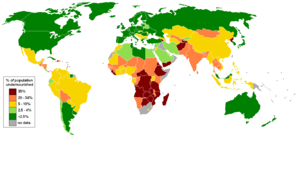Malnutrition
2008/9 Schools Wikipedia Selection. Related subjects: Health and medicine; Natural Disasters
Malnutrition is a general term for a medical condition caused by an improper or insufficient diet. It most often refers to undernutrition resulting from inadequate consumption, poor absorption, or excessive loss of nutrients, but the term can also encompass overnutrition, resulting from overeating or excessive intake of specific nutrients. An individual will experience malnutrition if the appropriate amount of, or quality of nutrients comprising a healthy diet are not consumed for an extended period of time. An extended period of malnutrition can result in starvation, disease, and infection.
Malnutrition is the lack of sufficient nutrients to maintain healthy bodily functions and is typically associated with extreme poverty in economically developing countries. It is a common cause of reduced intelligence in parts of the world affected by famine. Malnutrition as the result of inappropriate dieting, overeating or the absence of a "balanced diet" is often observed in economically developed countries (eg. as indicated by increasing levels of obesity).
Most commonly, malnourished people either do not have enough calories in their diet, or are eating a diet that lacks protein, vitamins, or trace minerals. Medical problems arising from malnutrition are commonly referred to as deficiency diseases. Scurvy is a well-known and now rare form of malnutrition, in which the victim is deficient in vitamin C.
Common forms of malnutrition include protein-energy malnutrition (PEM) and micronutrient malnutrition. PEM refers to inadequate availability or absorption of energy and proteins in the body. Micronutrient malnutrition refers to inadequate availability of some essential nutrients such as vitamins and trace elements that are required by the body in small quantities. Micronutrient deficiencies lead to a variety of diseases and impair normal functioning of the body. Deficiency in micronutrients such as Vitamin A reduces the capacity of the body to resist diseases. Deficiency in iron, iodine and vitamin A is widely prevalent and represent a major public health challenge. An array of afflictions ranging from stunted growth, reduced intelligence and various cognitive abilities, reduced sociability, reduced leadership and assertiveness, reduced activity and energy, reduced muscle growth and strength, and poorer health overall are directly implicated to nutrient deficiencies. Also, another, although rare, effect of malnutrition is black spots appearing on the skin.
Hunger is the normal psychological response brought on by the physiological condition of needing food. Hunger can also affect the mental state of a person, and is often used as a metonym for general undernourishment.
Politics
As of 2008, malnutrition continues to be a worldwide problem, particularly in lesser developed countries. According to the Food and Agriculture Organization of the United Nations, "850 million people worldwide were undernourished in 1999 to 2005, the most recent years for which figures are available" and the number of malnourished people has recently been increasing. An orange awareness ribbon is used to raise awareness of malnutrition in the world. The FAO calculates undernourishment by comparing the amount of food available in a country at national level with how many people live in the country.
Some environmentalists claim that the fundamental issue causing malnutrition is that the human population exceeds the Earth's carrying capacity; however, Food First raises the issue of food sovereignty and claims that every country (with the possible minor exceptions of some city-states) has sufficient agricultural capacity to feed its own people, but that the " free trade" economic order associated with such institutions as the International Monetary Fund (IMF) and the World Bank prevent this from happening. At the other end of the spectrum, the World Bank itself claims to be part of the solution to malnutrition, asserting that the best way for countries to succeed in breaking the cycle of poverty and malnutrition is to build export-led economies that will give them the financial means to buy foodstuffs on the world market.
Amartya Sen won a 1998 Nobel Prize in part for his work suggesting that famine is not typically the product of a lack of food; rather, famine may arise from problems in food distribution networks or from governmental policies in the developing world.
The politics of food trade and food security are often difficult to grasp. Many people believe that sending food aid to the poor of the world is a worthy idea, but that each country should produce its own food.
Countries that have become more open to international trade in recent years (e.g. China, Vietnam or Peru) have greatly reduced the prevalence of undernourishment as measured by the FAO (food energy consumption below acceptable minimum) or as measured by the World Health Organization by the percentage of children under five who are stunted, wasted or underweight. Countries that remained closed to external trade (e.g. North Korea) have not improved or have worsened their food situation.
Some anti-globalization groups advocate "food sovereignty", stating that each country should be physically self sufficient in every food item consumed by their people; by this measure the United States, United Kingdom, Sweden, Belgium, and in fact almost all other countries in the world would be food insecure, and a desert nation like Saudi Arabia (with its current population) would not be viable as a country at all.
One policy adopted in recent decades to alleviate world malnutrition is food aid, i.e. the physical donation of food from rich to poor countries. From the rich donor countries' point of view, this is a suitable way to reduce excess supply created by domestic agricultural subsidies, stabilizing farm prices in rich countries, even if the cost of supplying the food to its final beneficiaries is often disproportionately high. Food aid may be provided for short-term emergencies (natural disasters like earthquakes, tsunamis, droughts and floods, or human-made like war and refugee flows) or in the form of a long-term program for an extended period. From the viewpoint of recipient countries, the value of food-aid depends on the form it takes. Emergency food aid is welcome, though aid in cash may also be welcome because the food may often be purchased locally in zones not affected by the emergency, thus benefitting local farmers. Long-term foreign food aid has been criticized as discouraging local production and distorting markets. Instead, population control has been advocated as a much better approach to solve malnutrition/famine than merely providing food.

In recent years many foods, such as Spirulina and peanut butter, have been developed or refined for mass-production in hopes of combatting malnutrition and its effects. See IIMSAM and Plumpy'nut for more on these efforts.
Statistics
Number of undernourished people (million) in 2001-2003, according to the FAO, the following countries had 5 million or more undernourished people :
| Country | Number of Undernourished (million) |
|---|---|
| India | 212.0 |
| China | 150.0 |
| Bangladesh | 43.1 |
| Democratic Republic of Congo | 37.0 |
| Pakistan | 35.2 |
| Ethiopia | 31.5 |
| Tanzania | 16.1 |
| Philippines | 15.2 |
| Brazil | 14.4 |
| Indonesia | 13.8 |
| Vietnam | 13.8 |
| Thailand | 13.4 |
| Nigeria | 11.5 |
| Kenya | 9.7 |
| Sudan | 8.8 |
| Mozambique | 8.3 |
| North Korea | 7.9 |
| Yemen | 7.1 |
| Madagascar | 7.1 |
| Colombia | 5.9 |
| Zimbabwe | 5.7 |
| México | 5.1 |
| Zambia | 5.1 |
| Angola | 5.0 |
Note: This table measures "undernourishment", as defined by FAO, and represents the number of people consuming (on average for years 2001 to 2003) less than the minimum amount of food energy (measured in kilocalories per capita per day) necessary for the average person to stay in good health while performing light physical activity. It is a conservative indicator that does not takes into account the extra needs of people performing extrenous physical activity, nor seasonal variations in food consumption or other sources of variability such as inter-individual differences in energy requirements.
Malnutrition and undernourishment are cumulative or average situations, and not the work of a single day's food intake (or lack thereof). This table does not represent the number of people who "went to bed hungry today."
The U.S. Department of Agriculture reported that in 2003, only 1 out of 200 U.S. households with children became so severely food insecure that any of the children went hungry even once during the year. A substantially larger proportion of these same households (3.8 percent) had adult members who were hungry at least one day during the year because of their households' inability to afford enough food.
Overnourished vs undernourished
In 2006, Professor Popkin from the University of North Carolina, said there were now more overweight people across the world than undernourished people. He told the International Association of Agricultural Economists the number of overweight people had topped one billion (of which 300 million are obese), compared with 800 million undernourished. He added this transition from a starving world to an obese one was accelerating.
Mortality due to malnutrition
According to Jean Ziegler (the United Nations Special Rapporteur on the Right to Food for 2000 to March 2008), mortality due to malnutrition accounted for 58% of the total mortality in 2006: "In the world, approximately 62 millions people, all causes of death combined, die each year. In 2006, more than 36 millions died of hunger or diseases due to deficiencies in micronutrients".
Effects
An extended period of malnutrition can result in starvation or deficiency diseases such as scurvy. Malnutrition increases the risk of infection and infectious disease; for example, it is a major risk factor in the onset of active tuberculosis.
Malnutrition appears to increase activity and movement in many animals - for example an experiment on spiders showed increased activity and predation in starved spiders, resulting in larger weight gain. This pattern is seen in many animals, including humans while sleeping. It even occurs in rats with their cerebral cortex or stomachs completely removed. Increased activity on hamster wheels occurred when rats were deprived not only of food, but also water or B vitamins such as thiamine This response may increase the animal's chance of finding food, though it has also been speculated the emigration response relieves pressure on the home population.

